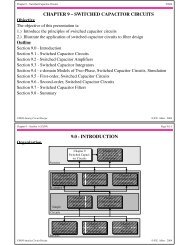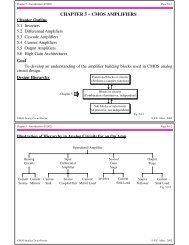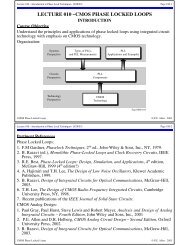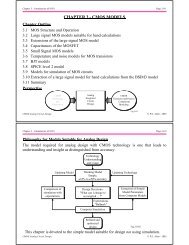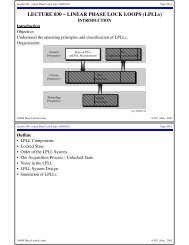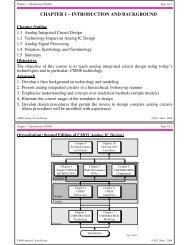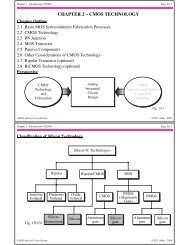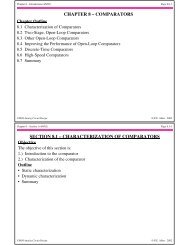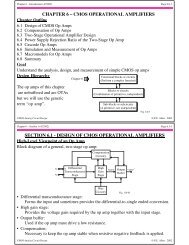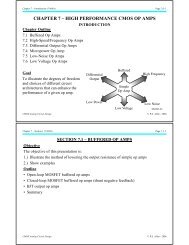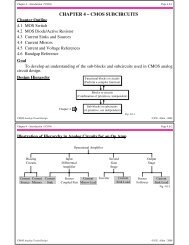LECTURE 040 –DIGITAL PHASE LOCK LOOPS (DPLLs)
LECTURE 040 –DIGITAL PHASE LOCK LOOPS (DPLLs)
LECTURE 040 –DIGITAL PHASE LOCK LOOPS (DPLLs)
Create successful ePaper yourself
Turn your PDF publications into a flip-book with our unique Google optimized e-Paper software.
Lecture <strong>040</strong> – Digital Phase Lock Loops (<strong>DPLLs</strong>) (09/01/03) Page <strong>040</strong>-35Phase Noise in a DPLL with a JK Flip-Flop and a PFDThe basic difference is that the JK Flip-flop and PFD are edge-triggered.When the input signal fades (v 1 →0), the reshaped signal can stick at a distinct logiclevel.Conclusion:The noise suppression of the DPLL is about the same for all phase detectors as long asnone of the edges of the reference get lost by fading. If fading occurs, the EXOR offersbetter noise performance.Summary of DPLL Noise Performance:P s = input signal powerP n = input noise powerB i = input noise bandwidthB L = noise bandwidth ≈ ω n2 ⎝ ⎜ ⎛ζ + 1 4ζ⎞⎟⎠SNR i = SNR of the input signal = P sP nSNR L = SNR of the loop = SNR iB i2B LCMOS Phase Locked Loops © P.E. Allen - 2003Lecture <strong>040</strong> – Digital Phase Lock Loops (<strong>DPLLs</strong>) (09/01/03) Page <strong>040</strong>-36DPLL DESIGN PROCEDUREDesign ProcedureObjective: Design K o , K d , ζ, and F(s)Given: Phase detector and VCOSteps:1.) Specify f 1 (min), f 1 (max), f 2 (min), and f 2 (max).2.) Design N unless otherwise specified.Given: ω n (min) < ω n < ω n (max) and ζ min < ζ < ζ maxFor these ranges we get approximately,ω n (max)ω n (min) =N maxN minandζ maxζ min=N maxN min→ N = N mean = N max N min3.) Determine ζ. Typically, ζ ≈ 0.7.4.) If noise is of concern, continue with the next step, otherwise go to step 12.5.) If there are missing edges in the input signal (fading), go to step 6, otherwise go tostep 7.6.) Choose an EXOR phase detector. Continue with step 8.K d = V OH-V OLπCMOS Phase Locked Loops © P.E. Allen - 2003




